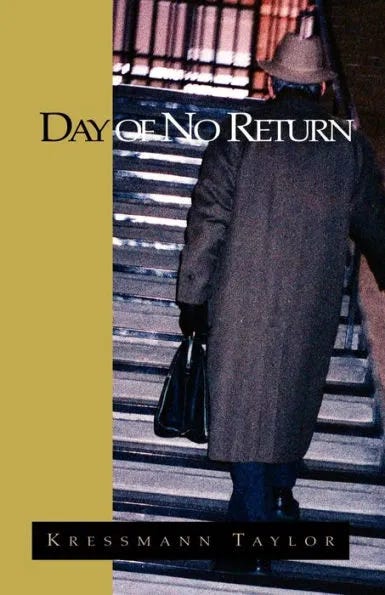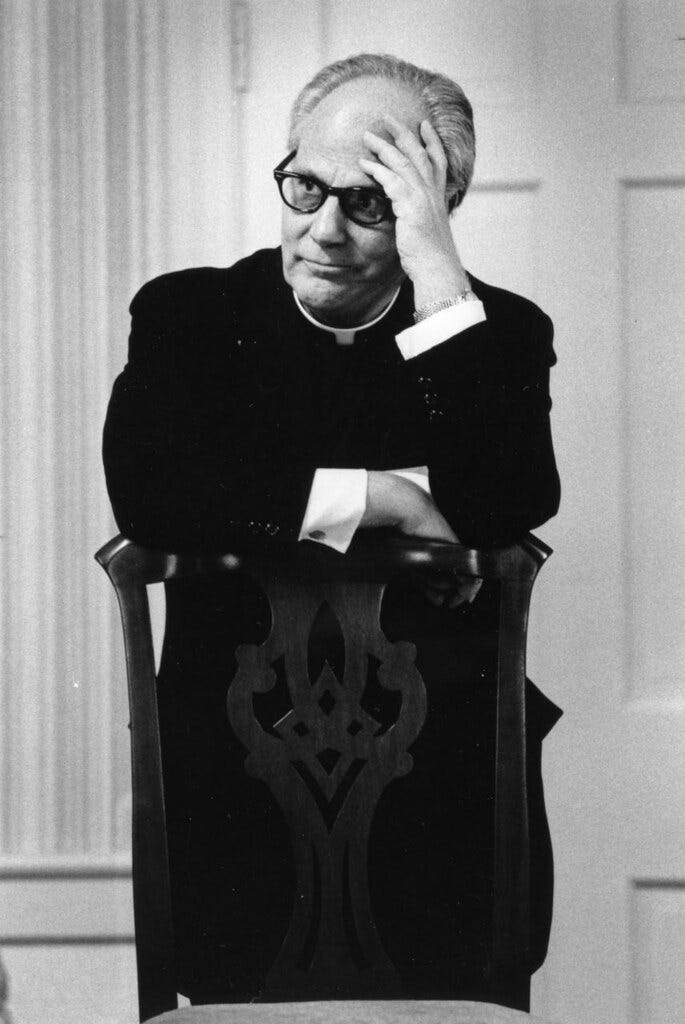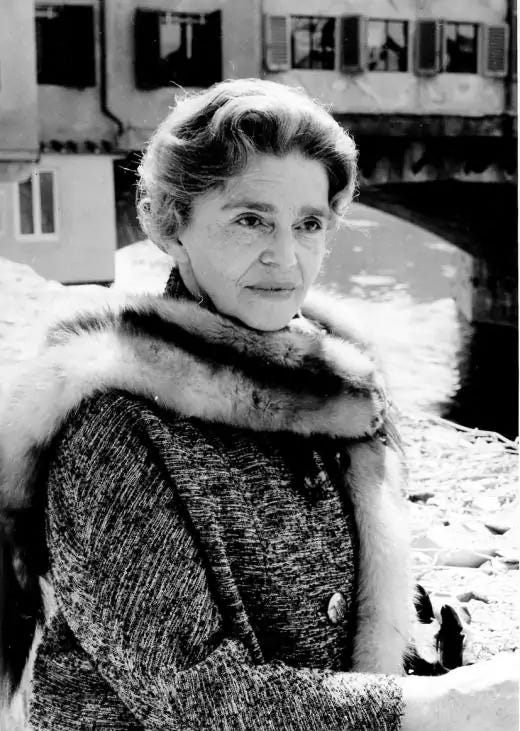The Swastika and the Crucifix
Book Profile: Day of No Return by Kathrine Kressmann Taylor
In 1942 a novel titled Until That Day by Kressmann Taylor was published. It was expected to be a bestseller, even optioned for a film. Taylor’s previous novel, Address Unknown (1938) was a popular epistolary novel about an American Jewish businessman and the downfall of his German business partner in Nazi Germany. Until That Day, too, stripped the varnished exterior of Nazism to expose the rot underneath. Taylor wrote the novel based on clandestine meetings, arranged by the FBI, with a German Lutheran minister who told his life story under strict rules of secrecy. He still had family in Germany to protect, but he wanted to expose the Nazi program to a nation with more than a few sympathizers.
However, 1942 saw the US enter the war in December. Media exposing the truths of Nazism no longer seemed as urgent while the US was actively in the war. Until That Day slipped away from public memory. Nearly sixty years later, Until That Day was retitled Day of No Return and republished in full, with additional material revealing the identity of its subject and publication history. The full name of the author, Kathrine Kressmann Taylor, was finally bestowed on her work.
Karl Hoffmann is the protagonist of the novel, a fictionalized version of Leopold Bernhard. Karl is the son of a Lutheran pastor who goes to seminary with hope for ordination. Yet, the church he hopes to join is swiftly changing from the church where he grew up. The government is getting involved in church politics. Faithful attendees dwindle. Karl calls the Nazi invasion of the Lutheran Church “one of the cleverest, the most subtle and measured of persecutions the Church of God has endured.” (37)
Orlando, Karl’s friend who has dedicated his life to the Nazi cause, tells Karl, “[L]ook how mysterious both our faiths are—and how much alike….You believe in salvation by the blood of Christ and I believe in salvation by the strong red stream that flows in all Aryans….We shall both be saved by blood!” (53) A few pages later, Karl has internalized Orlando’s meaning and feels its ramifications. He says, “Now the Nazis claim they will be saved by the Aryan blood. How much longer, I wonder, will they let us say that the only blood which can save us is the Blood of Christ?” (62)
The core ideals of Nazism, the blood purity, the eugenics, the xenophobia and racism, were not unique in their day. As John Carey argues in The Intellectuals and The Masses, the intellectual culture of pre-WWII Europe was primed for a system of mass extermination.1 It could have arisen in any country, for Germany was not alone in increasing antisemitic national laws in the 1920s-1930s. Germany, however, was economically depressed due to the disastrous German Reich2 and desperate for a prosperity gospel, even Hitler’s message of blood sacrifice.
Chapter eight brings us to church, the Lutheran congregation pastored by Karl’s father Franz. This Sunday morning sees Nazi storm troopers march in, taking up the front pews of church. Franz wonders, “Will the folds of the swastika hide forever the Crucifix, the symbol of our salvation?” (107) Taylor takes her readers through the entire liturgy of Lutheran worship, as the “martial display” (108) screeches against the ancient truths of the liturgy. Franz preaches:
“In these days we are hearing men say to us that new and stronger loyalties have arisen that can save us without the power of the risen Christ; but this battered Jesus,” he turned his eyes upward to the Crucifix, “bruised and tortured unto death, this exalted Christ, will light the hearts of the world for long centuries after the fungus growth of pagan mythology that sicken the air today have withered and died, for these have no truth in them nor strength to withstand the sunlight.” (109)
Day of No Return is a theological novel, yet the urgency of its storytelling makes the writing economical, even a page-turner. Karl’s life is at stake, but more important to him, Christianity in Germany teeters on the precipice.
Karl is a seminary student, and he sees the drama between the German Christians (the section of German Lutherans aligned with Nazism) and the Confessing Church (the section positioned against Nazism) play out in class, between his classmates and between factuly. In a debate between college professors, Karl hears, “There is no room in a German Church for a Jewish Messiah. Salvation lies in the Nordic blood and in that blood alone.” (148)
Karl Hoffmann is the fictional gloss of Leopold Bernhard, the man who met Taylor in secrecy. They met at a different place every time, came and left separately, and only had contact through the FBI. Bernhard had defected to the US to escape Nazism. He knew he had to leave after seeing his parishioners gather to cheer Hitler’s invasion of Poland. He could no longer maintain the integrity of his role as shepherd to a flock that rejoiced at violence.
Bernhard disguised his story slightly from reality to protect his family in Germany. He was not the son of a pastor, but used the figure of his childhood pastor (who died from Nazi persecution) as his father, to honor his legacy and tell his story. He wanted to speak against the “bombastic shibboleths” (137) of Nazism with the deeper truths of Christianity, even though Nazism used Christian language to promote their ideology. Not under Bernhard’s watch “would the folds of the swastika hide forever the Crucifix.” (107) Karl’s intellectual and emotional journey is Bernhard’s. Bernhard studied with Karl Barth and Emil Brunner, and like many others of the Confessing Church, had to choose between his life and his homeland.
Near the end of the novel, Bernhard asks in the voice of Karl, “We are exiles in our familiar place. How shall we sing the Lord’s song in a strange land?” (208) After defecting, Bernhard never returned to Germany. He served many Lutheran churches in the United States, ending his long and fruitful career at Reformation Lutheran Church in Washington, D.C.3
Kathrine Kressmann Taylor taught at Gettysburg College in Pennsylvania for many years, and is still widely known for her first novel, Address Unknown. Day of No Return has a lower profile in literary history, but it has a creative power worth encountering. While there are many novels of social change, fewer novels intimately examine the change of a national church from a place of holy welcome into a place that hangs a swastika in the sanctuary and denies communion to worshippers of Jewish descent. Day of No Return is an important work of American literature, for it was the United States that granted citizenship to Bernhard after his defection, and he led American Lutherans in the liturgy for the rest of his life.
As a historian, I appreciate Day of No Return as a portrait of a human life in a particular time and place so different from my own. As a reader, I value the power of the story and the riveting mode of its telling. As a divinity school graduate, I was especially struck by the portrait of ideological change sweeping a seminary, and how the faculty and students both effect and are affected by such changes.
Day of No Return is a novel I couldn’t put down. When I finished it, I couldn’t stop thinking about it. The next time you are looking for a thought-provoking read that is honest about the world, but looks toward a longer victory, I urge you to read Day of No Return.
For Bernhard and Taylor, the Nazi program did not rest on its politics, racism, or economic vision. That was only the “fungus [out]growth” (109) of Nazism that came from idolatry of Hitler and the “Aryan” race. Day of No Return explores the fear of God4 in a nation that is afraid of true religion.
But the thing [Nazis] were attacking did not lie in an organization. There was a look in men’s eyes—but you could not arrest them for that. There was hope in patient faces—but how are you to prove that hope is treason? There were words sounding in the air, commands from an unseen Leader, and against them the Nazis’ countercommands rang futilely down the wind. And the words were: ‘Thou shalt have no other Gods before Me.’5
D. H. Lawrence dreamed of exterminating the masses (the middle and lower classes, as opposed to his British blueblood society) by poison gas during a movie. In 1908.
Today this government is still known by the name Hitler applied to it in 1933, the Weimar Republic, but it did not self-style as such, nor was it called anything but Germany, the German Republic, or the German Reich in English-speaking countries during its tenure. Hitler wanted to co-opt the term Reich for his own purposes. Karl quotes him: “‘The Reich and the power and the glory forever, Amen.’ [Hitler] was posing as a prophet, not as a political leader. Or can you tell me that that one was only a political speech?” (61)
Local friends: Bernhard pastored in Glen Ellyn, IL in 1960.
The first questions of Martin Luther’s Small Catechism concern the Ten Commandments. Answers explaining each of the ten commands begin, “We should fear and love God.” Bernhard, as a Lutheran child turned Lutheran minister, would have known the Small Catechism.
From [Kathrine] Kressmann Taylor’s introduction to the 1942 edition.






Wow, this is fascinating! I've never heard of this author or the story of Bernhard. I'm so glad the story was re-published in full. I can think of a number of people who would love to read this novel. Do you remember how you first came across it?
Gosh it's chilling to think how quickly ideologies can sweep through groups in the church. I really loved Jaroslav Pelikan's interview with Krista Tippett all about Christian creeds when I listened to it years ago. He makes a point, if I remember correctly, about the significance of the Creed because if you can't articulate the beliefs of Christianity, then in your darkest moments, you won't know exactly what you're holding on to and defending. I might be elaborating on his original statement with my own thoughts. It's been a while. But I was reminded of that in thinking on how individual Christians have been called upon to withstand the forceful march of evil ideologies throughout history. Absolutely must add this one to my to-read list!